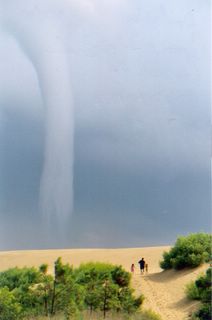Hatteras Access and the Bonner Bridge The next battleground
posted @ 7:53 AM
-
3 comments
Micheal Berry is back in Island Free Press writing about the next threat to access in the Cape Hatteras National Seashore. The Fish and Wildlife Service (FWS) has issued notice of new standards for "critical habitat" for wintering piping plovers. I can't begin to summarize the lengthy piece. It is carefully documented and well crafted. I suggest you read it. NOW!
Berry addresses a host of problems with the proposed designation including the relationship between the closures and public access to the beach:
The U.S. Fish and Wildlife Service should be very clear and open to the actual and probable impact of the critical habitat designation, especially about very likely lawsuits suits that can lead to the banning of ORVs from designated beaches.
In the notice, the FWS uses contradictory language when it states of page 28088:
"If implemented, these closures would reduce the opportunity for recreational activities such as ORV use. The Service believes, however, that additional beach closures due to designation of critical habitat for wintering piping plovers are unlikely."
Given the legal framework put in place regarding critical habit designation, the FWS is at least naïve in believing that litigation will not be forthcoming from environmental activists organizations that exist for the sole purpose of litigating and driving the public away from the national seashore. Currently, even without the critical habitat designation, thousands of citizens arrive at the Cape Hatteras National Seashore only to finds beaches closed for public use. In the face of critical habitat designation, the public anxiety about future beach closures and ORV prohibition will increase greatly.
Beach access is not the only thing threatened by these rules, Access to Hatteras Island may be impacted again. Want something to worry about read this:
One of the most disturbing sections of the critical habitat designation notice is the statement that the FWS makes related to the Bonner Bridge. The FWS "….plans to consult with the Federal Highway Administration on the replacement of the Bonner Bridge. At this time, it is unclear if these projects will affect the proposed revised critical habitat; therefore, this analysis does not include administrative costs associated with these projects."
This particular statement indicates that the FWS has not fully assessed the public safety aspects of the critical habitat designation impact, let along the economic full costs of the designation. It is governmentally irresponsible to place humans at risk in the name of protecting a single bird species, which is otherwise being successfully protected through thoughtful management processes that have been shown to be effective without the special legal designation of critical habitat.
Once again, it must be emphasized: The replacement of the Bonner Bridge is essential to the protection of human life and the economy of Hatteras Island. The critical habitat designation will add to the cost, and delay the construction of the much-needed Bonner Bridge.
The Va. Pilot notes that the environmental review of the Bonner Bridge plans has been delayed. DOT stresses that project is still on schedule but the article contains this little nugget:"...the completion date for the final environmental impact statement is delayed until August while information is await ed from the U.S. Fish and Wildlife Service on threatened and endangered species." Put this together with the proposed rules and you get a scenario that has FWS, which has long opposed the short bridge option, invoking piping plover protection to block it. No short bridge delays all the plans, eventually closes Pea Island to public access and adds hundreds of millions in costs. It also circumvents the entire environmental process used for permitting the bridge.
Some might say Berry and Bob(me) are being alarmist. I might have said that 6 month ago but the outcome of the SELC suit demonstrates that worst case scenarios can come true and without warning. We can see this one coming a mile away. Lets hope we can dodge it.
Thanks to Mike Berry for his work and to Irene Nolan at the IFP for publishing it. Go click some ads and support her, she is doing very good work.
Ciao
Labels: access, Bonner Bridge, Cape Hatteras, EIS, FWS, IFP, Michael Berrry, ORV, Pea Island, Va. Pilot








3 Comments:
Not only wintering birds. but migrating also. I suspect this article might apply to the FWS territory on Pea Island, but I've had adult piping plovers around my feet at both the Little & Big Hatteras surf fishing tourney's...these occur after breeding season but would easily allow the CHS enviros to use the same arguments during a time period (Sept & Nov) they have told us would be beyond the current scope of the "breeding" season bans. Not to mention turtles lay eggs as late as Sept; which translates to Nov hatchings all over Pea & Hatteras islands.
I heard today that the OLF opponents it Camdem County were using a fresh water mussel to shield them from development of an OLF. Be careful what you ask for...
While some environmentalist groups may protect you in certain situations - they may prohibit you in others.
You are not being an alarmist. A high-ranking FWS official told me in 2000 they'd never allow the replacement of the Bonner Bridge along the current path. When I asked why, he said, "Our name is Fish and Wildlife Service. Do you hear people in there anywhere?"
Post a Comment
<< Home